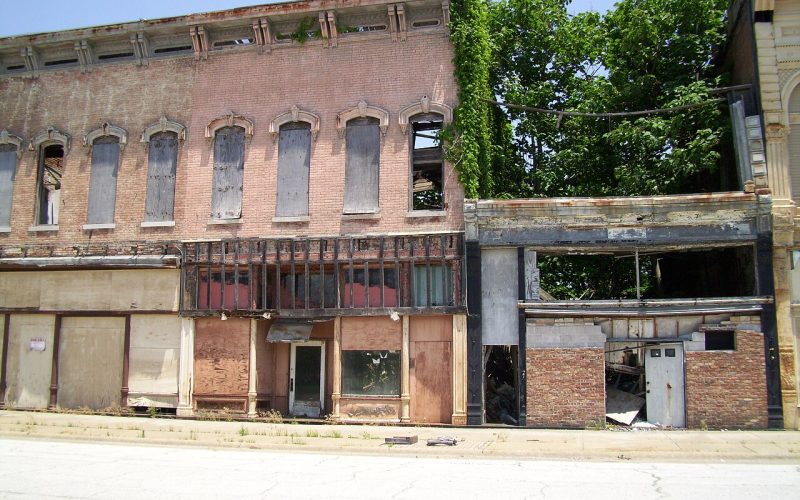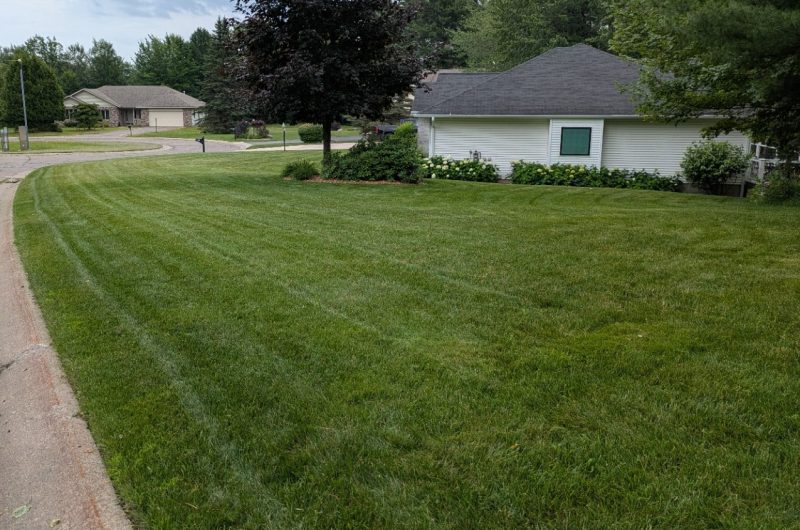Shrinking Population: Why It Matters

“America is uniquely ill-suited to handle a falling population,” so proclaimed a recent headline in The Economist.
The article’s author visited the city of Cairo, Illinois and surrounding Alexander County to illustrate the social and economic challenges confronting parts of America undergoing population decline. In Cairo’s case its population topped out in the 1920s at around 15,000, today its down to 1,700; while Alexander’s population is just 18 percent of its 1940s peak of 25,500.
To UP residents these figures have a familiar ring to them. The purpose of this article is to discuss the implications of a falling population for the region using The Economist’s framework, but first a brief overview of the reasons behind population decline is provided.
Slow Population Growth: A National and International Issue
The decade between 2010 and 2020 was the slowest period of US population growth since the Great Depression of the 1930s. The primary cause: a falling birth rate. The total fertility rate, a measure of how many children a typical woman will have in her lifetime, fell from 3.65 in 1960 to 1.61 in 2023, which is well below the figure of 2.1 that is necessary to maintain a stable population. A low fertility level is not unique to the United States, Canada’s fertility rate is 1.4, while China and Spain’s stand at 1.2.
Michigan’s Population Growth
Over the past 40 years Michigan’s population growth has lagged behind other Midwestern states and the US in general, growing just 8.6 percent between 1980 and 2021 compared with the US figure of 45.5 percent. The state’s slow population growth is a function of a falling birth rate and a net migration loss arising from more people moving out of state that moving to Michigan. As the 2023 Growing Michigan Together Council Report noted ‘it’s clear that population decline and its contributing factors are a significant threat to our state’s future prosperity and well-being.’
Implications of Population Decline
The Economist article argues a shrinking population “is bad for many reasons.” As people leave a community once prosperous businesses are forced to close. In the UP, according to County Business Pattern data, the number of private businesses fell between 2000 and 2020, from 8,981 to 7,590, a 13 percent drop. The largest percentage declines occurred in Alger (33%), Ontonagon (31%) and Gogebic (30%) counties. Alongside the drop in the number of businesses, total UP employment fell from 95,726 to 84,590, with Marquette being the only county where total employment increased.
A shrinking population poses challenges for local schools. In the UP, the number of children enrolled in local schools fell by nearly 25 percent between 2002-3 and 2023-4, with the largest losses in the western UP School districts, without enough students, schools struggle to maintain sports teams and other extra-curricular activities that help create a community.
As people leave and are not replaced it can lead to a fall in housing values. If the drop in housing values is sufficiently high, homeowners may stop maintaining their properties as the cost of repairs is higher than the return they will generate. The resulting blight, in turn, leads more people to leave as there is little incentive to stay and results in a ‘death spiral.’ This process has been played out across the UP for the past century as cities and towns have shrunk in size. In some instances, they disappeared entirely as is the case for the Keweenaw Peninsula’s ghost towns, places that were briefly occupied during the late nineteenth century and early twentieth century Copper mining boom.
One particular challenge for communities with a declining population is government worker pensions. As the population ages, the burden of paying for these pensions increases, but there are fewer people to help pay for them. The Michigan Department of the Treasury maintains a Community Financial Dashboard where it’s possible to identify the extent of unfunded pension liability (the difference between the current assets plus projected investment returns minus the total of all projected employee payments).
Taking for example, the three UP cities that have lost over a thousand persons over the past twenty years: Sault Ste Marie’s unfunded pension liability went from $17 million in 2011 to over $33 million in 2022; Menominee’s increased from $4.4 million to $9 million during the same period and Ironwood’s increased from $7 million to $9.1 million. The equivalent figures for Marquette, are $22.5 million and $41 million. In commenting about the pension liability issue for The Economist, Dr. Christopher Berry, Harris Professor of Public Policy at the University of Chicago noted succinctly, “Places that shrink are screwed.”
A shrinking population poses challenges for policy makers since they are well aware that the quality of life often worsens for those left behind. As a result, government officials are often prepared to invest state funds or provide support to private investors for job creation. In March of this year, for example, the Michigan Economic Development Corporation agreed to allocate $50 million toward the Copperwood Mine in Gogebic County, with its promise of 380 newly created jobs and $15 million in annual tax revenue. The mine is strongly opposed due to its proposed duration (11 years) and by environmental groups for its use of Lake Superior water, destruction of wetlands and plans to store mine waste over a vast area.
The challenges posed by Michigan’s lagging population growth were effectively encapsulated in the recently published, Growing Michigan Together report. “Michigan’s greatest strength is its people and we are losing them…And when they leave, our communities suffer from lost tax base and wages needed to support our public amenities, schools, roads, transit, and housing.”
The politics of decline are well documented. Among US counties that lost population between 2010 and 2020, 90 percent of them voted for President Trump in 2020, with his promise of Making America Great Again. Unless the country’s population grows faster more places are likely to shrink, posing a set of challenges for communities that are not easily overcome.






I’d say your negative impact of population decline is way over blown. The population of the UP has been declining for a century with none of the above occurring. As for pensions: the bulk of workers today with a pension program are teachers & government workers, everyone else has gone to a 401k program. Even those areas with population growth have pension problems (see Marquette). Business numbers do decline with fewer people but a likely bigger reason for fewer businesses is the advent of big corporate retailing like Walmart, Menards, Tractor Supply, grocery chains, Walgreens & huge corporate farms.
Agreed
Agreed
It is good that the issue of population growth nationally is getting some attention. The Great Recession of 2008-201? caused a significant decrease in births due to economic hardship (we see it in lower college populations for one thing today) and then the Trump immigration policies slowed even legitimate immigration. Businesses struggle for employees as Boomers retire. Prices go up (not just due to this, but one reason) and service values go down. The quality of life will decline, and economic growth will decline, and local pensions arent the only problem, this is already complicating the viability of Medicare and Social Security, both politically impossible to tackle.
The UP has of course been declining for years because its economy has been based on resource extraction which has its limits. (I tend to think of tourism/winter sports, etc. as another form of resource extraction by the way). The localities that have grown seem to have a better regional base of an economy not entirely based on resource extraction (Houghton and its area, and Marquette and its area). I am not totally against resource extraction, but its a perilous economic base usually.
Researching my spouses genealogy led us to Savanna Illinois last year. The story of Cairo sounds familiar , Savanna is a clearly declining city, boarded up main street, declining infrastructure and population decline. I will look at that Economist article, thanks.
A turn-around in a long term demographic trend is wishful thinking in developed countries and declining geographic areas.
We don’t know how to manage an economy without economic and population growth to cover over problems we don’t want to address.
Business in declining industries also don’t know how, or don’t want to learn how, to manage systemic decline: Carbon based fuel producers, Airlines, Automotive… Bailouts and protection do not constitute managing the problem. Every large scale solution now comes with new problems and huge marginal costs.
https://www.nytimes.com/2020/11/04/magazine/societal-collapse.html
It has long been said, “for the rich to be comfortable, the poor must be plentiful.”
That’s all any of this is about.
For the “conservatives” version of an economy to exist, they need a year over year 10% population growth of mindless consumers so they can achieve their minimum 10% returns for doing nothing. The problem is that you can’t have infinite growth on a finite planet.
The rich need more slaves.
This is a good article. It’s just too bad that you had too bad that you had to bring your unrelated left leaning politics into it at the end.
Its only leaning political becuase you don’t like the implication. The author states it as correlation, a fact in numbers, not tied to political pre-action or post-action. Just a correlation.
Sure, because they all voted for Trump in 2008 and 2012, right?
A first thought after reading the article was “someone hasn’t done very well with research”. Being from Northern IL and owning multiple secondary residential properties in Alger County over the past 30 years with the intention of making Alger Co my primary residence, some crucial information has been omitted. Over the past few decades the cost of housing in Alger Co has averaged about 50% (+/- 10%) less than the cost of housing in northern IL. In the past two years or so the value of real estate in northern IL has plummeted and of course our property taxes continue to rise substantially. During that same time housing in Alger Co has skyrocketed to a point of disbelief. The reasons for this is a subject of a different conversation. To the point, with the average income in Alger Co being less than $60k people have no choice but to leave. Local folks can no longer afford to live in their own homes let alone upgrade. People like me have come to realize that Alger Co is no longer an option due to enormously high priced housing. Actually to expensive to even come to visit. With more and more reports of tourists deciding to take “day trips” to the area rather than stay there because of costs. I can not comment on other parts of the UP but certainly this issue is the majority of the reasoning for the population decline, at least in this part of the UP. Very surprising to not see this issue mentioned.
let’s focus on the state government.. not national immigration issues..taxes are too high and only increasing ..many states that see an increase in population are states with no income taxes.. more liberty and less government oversight… 2 years ago michigan had a 2 billion surplus … did you get a rebate check .. or was that money spent on “special interests “ by the state … greed seems to be a driver in alger county and the lack of affordable housing is a major problem as well as sky high rents.. industry is definitely needed that would afford a decent standard of living
Population follows opportunity. When there are ways for a family to make a living and see a brighter future, no matter where, they move to that location. The UP grew when there was huge opportunities for employment in all the mining and timbering here. This dried up and without income, families moved away. Same today. Many move away as there are limited options for pursuing opportunities that exist in today’s UP economy. When opportunities get created in the UP for higher value jobs (hence higher paychecks), it seems we each find one issue to fight them instead of thinking about them fully.
The concept that Tourism is our future is a fools game. You end up like Lake Geneva – wealthy families who order around low paid service companies to cater to their every whim. No middle class and no opportunities. Look to the Huron Mountain Club as a shining example of tourism at it best – and worst.
We need industries like SpaceEx and more mines like Eagle Mine. To not support these, many claim they’re only protecting the “pristine” nature of the UP – ridiculous. Any photos from 1860’s through 1940’s shows that the forest up here was gone. The entire area was used very poorly by those people. I am nor promoting doing that again, but let’s be very realistic in how we view our area, the opportunities it can, and should, produce for our younger generations, then let’s do things responsibly.
Electric cars need huge amounts of minerals. Many think we should all drive them to save the planet. But we need large quantities of metals to make all those cars. Copper, nickel, etc. Hmmm, wonder where there are huge deposits of those metals? Maybe the UP? Seems like a win win. But many will say we need to protect the UP and have all that mining done with child labor in Africa. Their desire is to have all the benefits and push all the negatives somewhere else. Eagle Mine is an example of how a well run mining operation can be almost invisible but provides huge opportunities for many middle class families. We can be responsible in environmental protection while open up opportunities for people, and create a much stronger economic base. The challenge is for everyone to stop reacting based on beliefs and feelings only. We need rationale discussions that can produce forward momentum. A ‘holistic view” is required, not silo thinking.
Professor Broadway, I give your paper a D+ at best. You come up with “straw dogs” in an attempt to explain the decline. For example, unfunded governmental pensions is not caused by a declining workforce, but by accepting unrealistic investment returns resulting over the years in lower annual contributions by the governmental employer. Unfunded pension liability is not unique to UP governments. It is common among many governments throughout the US. Shifting from defined benefits to defined contributions is solving this problem. Generally, you provide statistics related to decline which in most cases are not unique to the UP or Michigan. The critical error in you paper is you don’t explore the real reasons for decline and compare the UP with other areas of the US where the opposite is true. I believe you will find that a significant reason is greater opportunity with lower taxes and less governmental regulation…and perhaps the weather. Finally, your last paragraph is totally irrelevant and unnecessarily political. It should have been deleted, because it contributes nothing to the paper. Remember, counties don’t vote for President, people do.
Communities, and on a larger scale civilizations, have begun, boomed and gone bust since the dawn of humankind. The reasons vary by geography, but ultimately come down to a lack of economic activity. People used to move to where the opportunity is, at least until LBJ’s “Great Society” started paying people to stay where there’s decline, decay and no hope for rebirth. Any commerce depends on employable workers regardless of where they’re located. Spending money on “safety net” programs only keeps people ensnared. Better to pay them to relocate. Staying in an economically depressed area causes people to lose hope and direction to be masked by the numbing effects of substance abuse. Immigrants used to strive to learn the language, customs and culture of America. Other programs that compensate “disability” deter personal growth. Almost everyone can contribute something to their well-being and social growth, but there is no incentive. Other leftist policies such as legalizing drugs make people unemployable, and the failed public education system goes hand in hand to prepare our next generations for absolutely nothing.
Immigrants used to come for opportunity and strive to become woven into the fabric of America by learning the language, customs and culture. “Multiculturalism” rejects Western philosophy for a conglomeration of incompatible ideologies that failed in their native countries and will not succeed here. They become another permanent underclass.
Certainly, cities, towns and even states may become depopulated, but that’s not always a bad thing as nature tends to reclaim what we’ve taken apart. No place can, or should, be permanently occupied.
So, no, throwing more money after bad is not the answer. After trillions of dollars in the “War on Poverty”, we have more than ever. (I’ve read a claim that it’s more than we’ve spent on every military war since the nation’s founding.) “The trouble with Socialism is that eventually you run out of other people’s money.” – Margaret Thatcher. Michigan will continue its slow decline with Governor Whitmer claiming we need a more socialist, even communist, approach. God help us all.
I live in a dying part of Pennsylvania they continue to hire more police and more teachers in places that are losing population .. their pensions and salaries and lawsuits against the communities that hire them are bankrupting every community in the United States.. everyone is afraid of them. everyone is afraid to say that they are not needed. everyone is afraid to say that they are bankrupting communities
[…] officers, the sustained low birth rate and the decline within the fee of pure enhance are adversely impacting the nation’s continued prosperity. Low charges of fertility and inhabitants decline are […]
[…] party officials, the sustained low birth rate and the decline in the rate of natural increase are adversely impacting the country’s continued prosperity. Low rates of fertility and population decline are […]
[…] gathering officers, the sustained low start fee and the decline within the fee of pure enhance are adversely impacting the nation’s continued prosperity. Low charges of fertility and inhabitants decline are […]
[…] party officials, the sustained low birth rate and the decline in the rate of natural increase are adversely impacting the country’s continued prosperity. Low rates of fertility and population decline are […]
[…] party officials, the sustained low birth rate and the decline in the rate of natural increase are adversely impacting the country’s continued prosperity. Low rates of fertility and population decline are […]
[…] party officials, the sustained low birth rate and the decline in the rate of natural increase are adversely impacting the country’s continued prosperity. Low rates of fertility and population decline are […]
This is such an important topic—thank you for shedding light on it! A shrinking population really does affect so many aspects of life in rural areas, from local businesses to schools and community support. I love that you’re focusing on finding solutions instead of just highlighting the problems. It’s conversations like this that can spark real change! Thanks again.
Great discussion of a complex topic. Thoughts on reversing the decline in a way that enhances quality of life:
1. Appeal to folks able to telecommute; low housing cost, and significant access to 4 season outdoors activities (leverage the tourism angle). Likely need an active regional airport since the telecommuters often need frequent face time in the office/project site. May need to find an interested college as this will enhance cultural opportunities for the parents, and educational opportunities for their kids (including pre college since academics place a strong priority on education, as will professional parents.)
2. Appeal to the crypto and AI folks who need lots of cheap energy to fuel their servers; perhaps wind, modular nuclear, maybe solar fields. Leverage cheap land. Ideally MAKE THEM pay for the new electric generators (at last start here in negotiations).
All this assumes your area is a great place to live, but work opportunities are too few.
Great Article! I took a class once about Detroit Life and how the population had shifted every ten years and the impact it had on the city. One minor critique is that the article focuses heavily on economic and governmental perspectives but does not explore as much on the cultural and personal aspects of population decline.
The UP’s experience mirrors broader trends observed in other areas confronting population decline. For instance, in Japan, a declining population has led to concerns about economic stagnation and increased pressure on social welfare systems. Similarly, parts of Eastern Europe have experienced labor shortages and economic contraction due to significant population decreases
[…] population growth started during COVID the fact is that it has been ongoing since 2010. The slowest rate of population growth in the United States since the Great Depression of the 1930s happened between […]